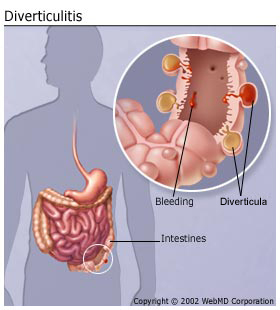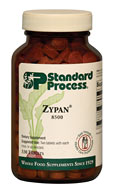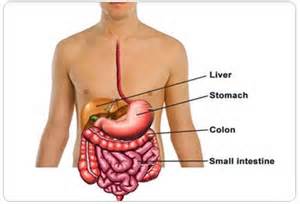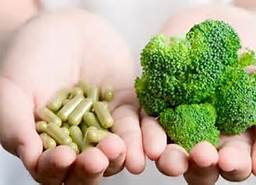Diverticulitis

|
a sick, its prison." Francis Bacon |
Diverticula are small pouches in the wall of the digestive tract. They occur when the inner layer of the digestive tract bulges through weak spots in the outer layer. Although these pouches can occur any place including in your esophagus, stomach and small intestine, most occur in your large intestine (colon), especially the left (lower) portion of the colon just before the rectum.
If you're older than age 40, it's common for you to have diverticulosis - small, bulging pouches (diverticula) in your digestive tract. In the United States, more than 50 percent of people older than 60 have diverticula. Some researchers speculate that 65% of those who are 85 years old or older are affected by diverticulitis. Other researchers suspect that this number is greater. Not all of these people will go on to develop an intestinal infection, or diverticulitis.
The colon (large intestine) is a long tube-like structure that stores and then eliminates waste material. Pressure within the colon causes bulging pockets of tissue (sacs) that push out from the colonic walls as a person ages. A small bulging sac pushing outward from the colon wall is called a diverticulum. More than one bulging sac is referred to as diverticula.
In every human being, this last bit of the colon winds its way down the lower left side of the abdominal cavity. This region is called the sigmoid colon. It is where most cases of diverticulitis develop. The less movement the bowels experience, the more prone they are to developing diverticula. This is because the final portion of the colon is narrower than the rest of the large intestine. Sometimes the equivalent of a traffic jam can happen in the sigmoid colon.
Since the 1920s, the incidence of diverticulitis has risen. This has happened concurrently with the development of refined foods and flours, all which can gum up the intestines, give rise to the balloon-like diverticula, and promote intestinal infection. Diverticular disease is common in the Western world but is extremely rare in areas such as Asia and Africa.
Is it possible to improve diverticulitis without the use of antibiotics? Because diverticulitis is an infection in the intestines, your doctor will suggest rest, antibiotics, and sometimes prescribe medication to relieve the pain. Often, the conventional treatment requires several days of bed rest while waiting for the infection to subside.
- What causes of diverticulitis
- What are symptoms
- Why eating raw and green vegetables is not a good idea
- What are simple things you need to do to relieve the pain
- 8 steps that naturally prevent and improve your diverticulitis











